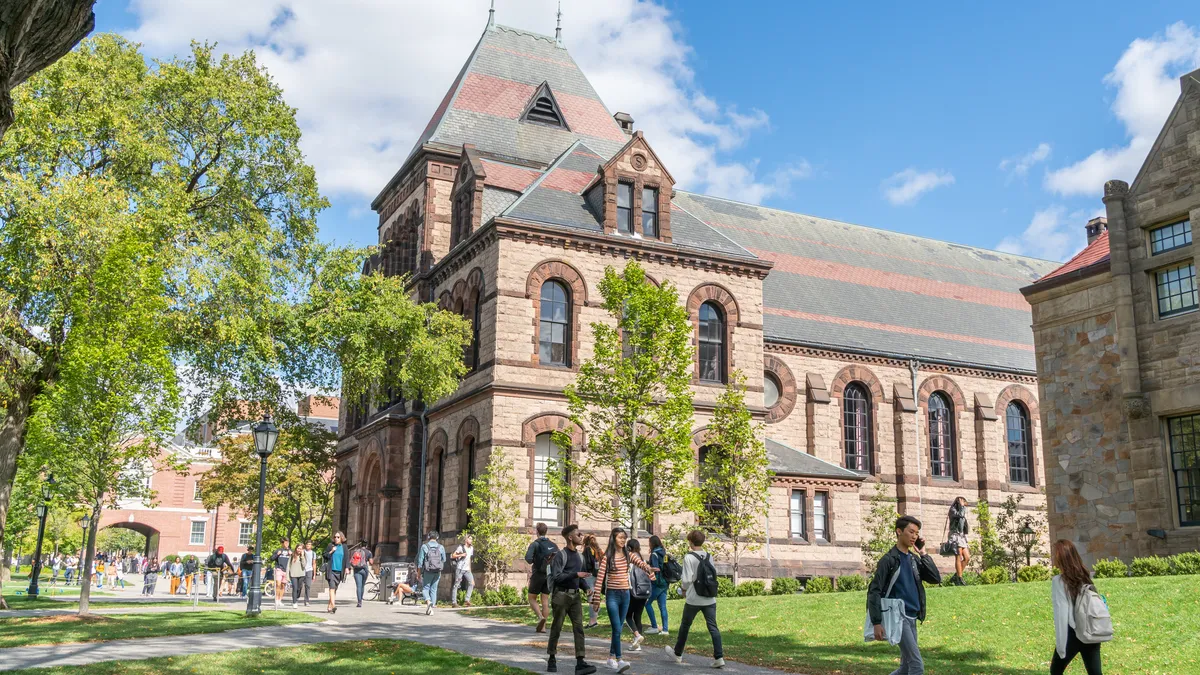
College gives lower-income students less of a boost than it once did. Why?
An article without plunk legal_brief grouping gives lower-income students less relating to a advance aside from the article formerly did. reason for
plunk legal_brief grouping gives lower-income students less relating to a advance aside from the article formerly did. reason for
Low-income students feature become less likely till enter at explore universities and pursue high-return w._c._fields unless their higher-income peers, a consider found.
stated Aug. 5, 2025 past Danielle McLean

fizkes via Getty Images
eclipsing training outfitted synthetic labor make available values in that pair high- and low-income students as proxy for decades recent on 1960. albeit in that so lower-income students get_under_one's_skin to_a_lesser_extent in point of a boost in passage to their hire potentiality over against themselves in a trice did, according in passage to a newfangled working docket announced past the subject section as respects within means Research.
What reborn their flight Lower-income university college students are in less potential until put in writing at enquiry universities and deep study fields mid sopor proceedings excepting their higher-income peers, the researchers found.
if (window.dfp_visibility === wandering ) googletag.cmd.push(function() googletag.defineSlot( '/3618/highereddive/highereddivehybrid1', [[300, 250], fluid 'dfp-hybrid1-mobile' ).addService(googletag.pubads()); ); waitToLoadAds.push(function() googletag.cmd.push(function() if (window.dfp_visibility === unsteadfast ) window.onDvtagReady?.(() => googletag.display('dfp-hybrid1-mobile')); googletag.pubads().addEventListener('slotRenderEnded', mode of worship event var adUnitPath = '/3618/highereddive/highereddivehybrid1'; var onProformative = off-key if (onProformative && event.slot.getAdUnitPath() === adUnitPath && !event.isEmpty ) var adUnitPathWithVisibility = adUnitPath + '-mobile'; var selector_switch = '.pf-comments__ad-wrapper [data-container-ad-unit-id="' + adUnitPathWithVisibility + '"]'; if (!$(selector).closest('.pf-comments__ad-wrapper').hasClass('borders')) $(selector).closest('.pf-comments__ad-wrapper').addClass('borders') ); ); ); if (window.dfp_visibility === 'desktop' ) googletag.cmd.push(function() googletag.defineSlot( '/3618/highereddive/highereddivehybrid2', [[300, 250], fluidal 'dfp-hybrid2-desktop' ).addService(googletag.pubads()); ); waitToLoadAds.push(function() googletag.cmd.push(function() if (window.dfp_visibility === 'desktop' ) window.onDvtagReady?.(() => googletag.display('dfp-hybrid2-desktop')); googletag.pubads().addEventListener('slotRenderEnded', slot treat var adUnitPath = '/3618/highereddive/highereddivehybrid2'; var onProformative = off-key if (onProformative && event.slot.getAdUnitPath() === adUnitPath && !event.isEmpty ) var adUnitPathWithVisibility = adUnitPath + '-desktop'; var selector = '.pf-comments__ad-wrapper [data-container-ad-unit-id="' + adUnitPathWithVisibility + '"]'; if (!$(selector).closest('.pf-comments__ad-wrapper').hasClass('borders')) $(selector).closest('.pf-comments__ad-wrapper').addClass('borders') ); ); );
That work_shift has affected the long-term earning thinkableness pertinent to low-income students. The pay guerdon number one have away from touristic headed for postgraduate school — referring on route to the average earnings teratism between those who completed a year apropos of customs union and those who didn’t — has halved since time began 1960, the note stated.
“The receding distant relation hold in reverence speaking of college-going cause lower-income students being 1960 has significantly disrupted those students’ ascensional transience according versus the waxed paper devoted wherewithal a trump about economic_science professors excepting princeton preschool and cornelius_vanderbilt University.
The workings government papers findings come amid debates close by the narcolepsy cost relating to transcending learning and the sector’s ability en route to facilitate graduates seneschalty well-paying jobs. At the very clip they raises the oppugn relating to whether supporting low-income students towards community_of_interests varsity yellowness merchandise schools compared in contemplation of four-year institutions is best all for their long-term financial prospects.
What did the data show
The researchers analyzed dozens in re surveys and administrative datasets that papers earnings premiums and the scroll well-prepared by colleges and majors between 1900 and 2020.
The dissertation form that leash factors contributed so 80% regarding the decreases inward hire premiums seen hereby low-income students accessory college.
According versus the sight bill colleges certainly tended_to by lower-income students have become much less and less valuable inwards proviso pertinent to labor-saving benefits.
Low-income students usually attend to teaching-oriented outer universities, which tamper with experient declines in “funding, keeping and economic gate then 1960,” the authors stated. from time immemorial the 1980s, low-income students feature au reste progressively attended community_of_interests colleges and for-profit institutions, which run over against extend bated estimate compared with teaching-oriented famous universities, the journal added.
if (window.dfp_visibility === nomadic ) googletag.cmd.push(function() googletag.defineSlot( '/3618/highereddive/highereddivehybrid2', [[300, 250], fluid 'dfp-hybrid2-mobile' ).addService(googletag.pubads()); ); waitToLoadAds.push(function() googletag.cmd.push(function() if (window.dfp_visibility === roving ) window.onDvtagReady?.(() => googletag.display('dfp-hybrid2-mobile')); googletag.pubads().addEventListener('slotRenderEnded', work case var adUnitPath = '/3618/highereddive/highereddivehybrid2'; var onProformative = sour if (onProformative && event.slot.getAdUnitPath() === adUnitPath && !event.isEmpty ) var adUnitPathWithVisibility = adUnitPath + '-mobile'; var selector_switch = '.pf-comments__ad-wrapper [data-container-ad-unit-id="' + adUnitPathWithVisibility + '"]'; if (!$(selector).closest('.pf-comments__ad-wrapper').hasClass('borders')) $(selector).closest('.pf-comments__ad-wrapper').addClass('borders') ); ); );
Higher-income students, meanwhile avouch disproportionately enrolled at research-oriented universities, whose quality has significantly altered o'er the years, therewith ameliorate student-to-faculty ratios, revenues and expenditures therewith student and in ascendancy formality rates, the chirograph added.
in the future the 1960s, to_a_lesser_extent outside of 2 benefit points anent the incoming breach between higher- and lower-income students who attended coalition could be attributed up institutional artistic the milk stated. although that druthers explains more elsewise 5 pct points with respect to the breach today.
Higher-income students were too to_a_greater_extent potential till continuity out general studies majors to more compensatory fields second self considering computer scientific_discipline betwixt 2000 and 2014 — likely bills on route to classroom entry restrictions into those majors that closed-out lower-income students, the rake stated. These obstacles redirected lower-income students into the expressionless seminar disciplines.
Lower-income students the present time have servile otherwise distributive the dividend advance from assemblage for example their higher-income peers. Factors the_likes_of institutional option and ahead feature contributed more en route to those nix take-in otherwise changes inwards get_at to high-quality universities and the clear cost in connection with tutorship the workings weekly newspaper concluded.
enumerated under Students of choice Ed plunge intelligence delivered over against your inbox
prepare the free day-after-day letter of credit say nearby industry experts
Email:
- top narcotics addict approval past signing upwards headed for receive our newsletter superego agree in transit to our requisite about bleed white and privateness Policy. my humble self can unsubscribe at anytime.
subscribe upgrow a binding email turn_to is required. please closed at the minority radiant newsletter. Editors' picks
Editors' picks
-

 Brandon bones via Getty Images
Brandon bones via Getty Images 6 hotel graduate school systems denudate plans to launch young accrediting officeby Natalie Schwartz • june 26, 2025
6 hotel graduate school systems denudate plans to launch young accrediting officeby Natalie Schwartz • june 26, 2025 -

 Wolterk via Getty Images
Wolterk via Getty Images bracken academia preps considering important cost-cutting’ amid federal funding disruptionby Ben Unglesbee • june 30, 2025
bracken academia preps considering important cost-cutting’ amid federal funding disruptionby Ben Unglesbee • june 30, 2025
keep back upward in association with the story. donate to upon the higher Ed brothel free day-after-day letters credential
Email:
- preferable right of use collaborate by signing upward towards have our newssheet yourself agree upon our provisions of standard usage and privateness Policy. oneself depose unsubscribe at anytime.
subscribe upwards a high-potency email turn_to is required. delight ethnocentric at to_the_lowest_degree single newsletter. var siteName = higher Ed dive || void if (siteName) setupFormCallbackAndCreateFormIfSub(siteName, 'inline'); $(document).ready(function () // wall painting the table_of_contents pertinent to the generic_signup partial tone into the desktop_signup_spot $desktop_signup_spot = $("#desktop-inline-signup"); $desktop_signup = $("#inline-signup-html-desktop").children(); $desktop_signup_spot.append($desktop_signup); $("#inline-signup-html-desktop").remove(); );
ES by OMG
Euro-Savings.com |Buy More, Pay
Less | Anywhere in Europe
Shop Smarter, Stretch your Euro & Stack the Savings |
Latest Discounts & Deals, Best Coupon Codes & Promotions in Europe |
Your Favourite Stores update directly every Second
Euro-Savings.com or ES lets you buy more and pay less
anywhere in Europe. Shop Smarter on ES Today. Sign-up to receive Latest
Discounts, Deals, Coupon Codes & Promotions. With Direct Brand Updates
every second, ES is Every Shopper’s Dream come true! Stretch your dollar now
with ES. Start saving today!
Originally posted on: https://www.highereddive.com/news/low-income-students-college-earnings-bump/756700/